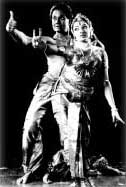 The Kuchipudi dance drama came into existence in the 17th century through the Bhakti cult in the small village of Kuchipudi in Andhra Pradesh. Kuchipudi was once completely male dominated, who performed the female parts as well. Kuchipudi consists of three phases of historic art as contained in the Hindu texts namely nritta, nritya and natya. Nritta using adavus and Jatis is pure dance comprising of movements of limbs and foots working more or less on per with the sadir of the nritta.
The Kuchipudi dance drama came into existence in the 17th century through the Bhakti cult in the small village of Kuchipudi in Andhra Pradesh. Kuchipudi was once completely male dominated, who performed the female parts as well. Kuchipudi consists of three phases of historic art as contained in the Hindu texts namely nritta, nritya and natya. Nritta using adavus and Jatis is pure dance comprising of movements of limbs and foots working more or less on per with the sadir of the nritta.
 Kuchipudi plays are enacted on an improvised stage in the open air. The performance takes place only at night. It begins with certain stage rites performed in full view of the audience. The conductor (sutradhara) and the musicians come on the stage and play a rhythm on the drums and cymbals. They sing a prayer in the honour of the Goddess of the temple at Kuchipudi.
Kuchipudi plays are enacted on an improvised stage in the open air. The performance takes place only at night. It begins with certain stage rites performed in full view of the audience. The conductor (sutradhara) and the musicians come on the stage and play a rhythm on the drums and cymbals. They sing a prayer in the honour of the Goddess of the temple at Kuchipudi.
The sutradhara then recites a 'sloka'(holy hymns) explaining the theme and purpose of the play after which the main characters enter the stage. The music in Kuchipudi is classical carnatic. The sutradhara is the principal singer and conductor of the play. Kuchipudi is more earthly and more accommodative to ragas like shringara.



